|
|
|
 |
|
 |
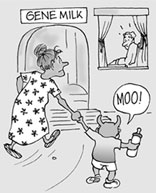
|
|
|
 |
Fifteen major corporations control the global biotech
research, 13 of which are North American, known as the ‘Miami Group’. |
 |
Small bio-diverse farms can produce a lot more food than
large monocultres farms. Producing different types of crops by rotation helps prevent
drought and also keeps the soil nourished with its nutrients. |
 |
According to the Department of Biotechnology, the demand for
GMOs in India amounted to US$ 1850 million in the year 2000. |
|
|
|
|
| What
is a GMO? |
Genetic modification is the
process by which the genetic material of any living organism (plant, animal or
micro-organism) is altered in order to bring about a required change. This change is not
through any natural process but done in laboratories. It is a well thought out, planned
action. What then is genetic material?
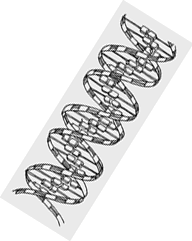 All
living things are made of cells. The control centre of all plant and animal cells is
called the nucleus, which contains thread-like structures called chromosomes. Chromosomes
are made up of the genetic material -- deoxyribonucleic acid (DNA) and ribonucleic acid
(RNA). DNA is made up of sugars, phosphates and nitrogen bases. It looks like two strings
of beads coiled around each other. DNA and RNA carry 'genetic codes' that represent the
characteristics of an individual. During reproduction, DNA or RNA passes from the parent
cells into the new cells and eventually the offspring (be it a plant, animal or
micro-organism) gets characteristics similar to that of its parents. If changes,
modifications and mixing of two or more organisms are made in the genetic codes of DNA or
RNA, the changes will pass on from generation to generation. Humans have conducted
selective breeding procedures for a long time to produce desirable characteristics -- for
example, to increase yields or to resist disease. Two or more varieties of a crop are
crossbred to create a new variety that has the best characteristics of each. This process
is very slow and it may take years to obtain a ‘perfect’ organism. Radiation has
also been used to change the genetic characteristics of seeds. This is called mutation.
The mutated seeds are then crossbred with other varieties. These processes are called
hybridisation. All
living things are made of cells. The control centre of all plant and animal cells is
called the nucleus, which contains thread-like structures called chromosomes. Chromosomes
are made up of the genetic material -- deoxyribonucleic acid (DNA) and ribonucleic acid
(RNA). DNA is made up of sugars, phosphates and nitrogen bases. It looks like two strings
of beads coiled around each other. DNA and RNA carry 'genetic codes' that represent the
characteristics of an individual. During reproduction, DNA or RNA passes from the parent
cells into the new cells and eventually the offspring (be it a plant, animal or
micro-organism) gets characteristics similar to that of its parents. If changes,
modifications and mixing of two or more organisms are made in the genetic codes of DNA or
RNA, the changes will pass on from generation to generation. Humans have conducted
selective breeding procedures for a long time to produce desirable characteristics -- for
example, to increase yields or to resist disease. Two or more varieties of a crop are
crossbred to create a new variety that has the best characteristics of each. This process
is very slow and it may take years to obtain a ‘perfect’ organism. Radiation has
also been used to change the genetic characteristics of seeds. This is called mutation.
The mutated seeds are then crossbred with other varieties. These processes are called
hybridisation.
Today, the laboratory processes (in making a GMO) that are used to manipulate this
DNA or RNA genetic codes are like the process of cutting and pasting. Strands of DNA, the
basic chemical of life which produce a particular effect in one living organism, can be
'cut' and then 'pasted' into the DNA of another living organism. The genetic strands are
'trimmed' so that only a precise, fully defined piece of DNA is pasted into the recipient
organism. The process of GMO making uses advanced molecular techniques.
The Promise...
a) Food production -- an area in which biotechnology plays a significant
role is the production of vitamins, and enzymes for food processing.
b) Agriculture -- fruits and vegetables can be improved in appearance, taste, nutrient
content, shelf life, resistance to pests and even stability under unfavorable climatic
conditions.
c) Plants -- better yield, more efficient use of land, lesser use of herbicides,
pesticides and other chemicals
d) Medicine -- new methods of producing critical vaccines that are cheaper
e) Environmental management -- biotechnology offers new opportunities for the protection
of the environment, for example, genetically modified bacteria may one day be used to
convert non-biodegradable wastes to useful products.
...and the risk
a) Unintentional introduction of allergens and other anti-nutrients in
foods and soils
b) Escape of transgenes from cultivated crops into wild relatives. These may affect or
reduce plant species in natural communities, or influence diversity of wildlife as a
result of changes in available food and food sources
c) Super weeds may play havoc in the wild, being resistant to most herbicides and pests
d) Transgenic crops carrying antibiotic genes may generate antibiotic resistance in
livestock or humans
e) Pests may evolve resistance to toxins produced by GM crops
f) Toxins of GM crops may affect non target pests
g) Small farmers will lose out as the technology cost is very high, while the price of
products, low
h) The technological development has a hazy future |
|
| Biotech: Big
Business |
Two cases of forest
management. As different as the two sides of a coin. One says people please, the other
says, Indigenous people, who?
Why do we need GMOs? Top corporations based in rich developed countries have invested a
lot of money in the research and development of these modified crops. These conglomerates
say that genetic modification increases the yield of the land. Scientists and
environmentalists on the other hand believe it is still a rich man's technology as it is
financially beneficial to produce products for the supermarket. Are high returns the
reason why conglomerates propagate GM crops as the only solution to world hunger?
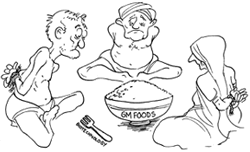 Global
Biotech research is controlled by 15 major corporations, of which 13 are in North America,
known collectively as the ‘Miami Group’. In 2000, about 109.2 million acres were
planted with transgenic crops. Countries that grew 99 per cent of these crops worldwide
include the United States (68 per cent), Argentina (23 per cent), Canada (7 per cent), and
China (1 per cent). Global
Biotech research is controlled by 15 major corporations, of which 13 are in North America,
known collectively as the ‘Miami Group’. In 2000, about 109.2 million acres were
planted with transgenic crops. Countries that grew 99 per cent of these crops worldwide
include the United States (68 per cent), Argentina (23 per cent), Canada (7 per cent), and
China (1 per cent).
The US is the largest producer of GMOs in the world. In 1999, it exported $60 billion in
agriproducts. Having the largest interest in the market, it dictates rules. It also
detests any regulation in the biotechnology laws.
Environmentalists cry foul. Excluding Argentina and China, the developing world accounts
for only a one per cent stake in this business. But it is this one per cent that bears the
brunt of these
partisan policies. |
|
Who fears GMOs?
Farmer and consumer groups are cautious |
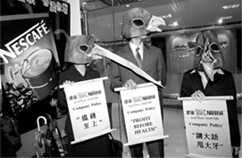 The 'gene
revolution', like the 'green revolution' could boost food production, say the GMO
propagators. But they forget that the 'green revolution' was a government initiative the
world over benefiting the marginalised farmer (though it later flipped over to benefit the
pesticide industry). About 80 per cent of biotech firms are private conglomerates that
spend huge sums in developing the technical know-how and are solely driven by the profit
motive. The 'gene
revolution', like the 'green revolution' could boost food production, say the GMO
propagators. But they forget that the 'green revolution' was a government initiative the
world over benefiting the marginalised farmer (though it later flipped over to benefit the
pesticide industry). About 80 per cent of biotech firms are private conglomerates that
spend huge sums in developing the technical know-how and are solely driven by the profit
motive.
Samuel Ochieng of the Kenya Consumer Information Network says, “We are not
saying there are no benefits.The issue is that we are being rushed and their is not enough
consultation”.
|
|
Small Farmers
Threat to their control over seed varieties
Take the case of Percy Schmeiser, a farmer in Canada. He was taken to court by
Monsanto, the largest GM corporation in the world, because some GMO canola plants were
found in his fields. This plant, whose fruits bear canola oil, are wind pollinated. The
court ordered that it didn't matter how it landed up in Schmeiser's field but it was his
fault that they were growing in his field. Schmeiser, a recipient of the Mahatma Gandhi
Award in the year 2000, lost the case and had to pay a sum of US$ 1,53,000 as compensation
to the multinational biotech company.
Environmentalists also fear that the Third World countries having weak laws can be
made into safe havens for experimenting with these crops.
Consumer
Very suspicious of the health effects
Food is a special case. Anyone desirous of making changes into what is eaten must
listen to consumers. Clear labeling, revealing how much of what is contained in the
product, is therefore vital. Consumers have the right to know and choose whether to eat a
GM product. About 90 per cent of the GM exports is meant for human consumption. No wonder
consumers the world over are worried. Research has found that rats fed with GM potatoes
have developed higher white blood cell count, implying that our bodies have a negative
reaction. Other research has shown allergic reactions in humans after eating GM corn and
even the deaths of monarch butterflies in cornfields. Consumers are anxious. Moreover,
vegetarian consumers may not like their greens to be contaminated with animal genes.
The magazine New Scientist sums this up: “Despite a few alarms, there's no real
evidence that GM crops have hurt human health or environment in spite of their steady rise
in use. But neither have they made the world a much better place.” |
|
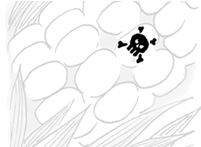
|
CONTROVERSIAL CROPS
Who takes the blame if GMOs cause harm to human health or the environment? |
|
MEXICO
has a large number of wild corn varieties. Since 1998, GM crops, and particularly GM corn,
has been banned in the country. The January/February, 2002 issue of the World Watch
journal, however, reports that a team of scientists studying corn varieties in remote
parts of Southern Mexico has found contamination in Bt corn. Contamination has become a
common fact of life for Mexican farmers. Before the ban, Mexico was doing field trials of
the GM crop. Farmers are still planting seeds taken from some 4-5 million tonnes of corn
that Mexico imports from US annually (supposedly not GM). The team of scientists working
with indigenous people in the province of Oaxaca detected the genetic material from a
variety of seeds patented and sold by one of the leading biotech corporations, including
Novartis and Monsanto. They also found genetic material in the corn that could prove
harmful to a wide range of butterflies, moths and a host of other insects.
INDIA Cotton, also called the 'white gold' is among the nation’s
most important cash crop. The government invited Monsanto Inc. in 1990 to introduce Bt
cotton, but they were not allowed to do field trials due to widespread protests by
environmentalists. In 1995, permission was finally granted to Maharashtra Hybrid Seeds
Company (MAHYCO), an Indian subsidiary of Monsanto to import seeds. More than Rs 5 crores
was spent in the project. |
|
| Controlling the Genie |
China is taking its GMOs
seriously. GMO research in the country amounted to US$ 112 million in 1999. By the year
2005, it is expected to increase by 400 per cent.
China also has stringent GMO laws. In June 2001, a comprehensive labeling system on GMO
seeds and food products was introduced. The new law safeguards biodiversity, environment,
and human health, against the potential adverse effects of GMOs.
In India, the agriculture minister claims that very soon all agri product importers will
have to fill in a mandatory form notifying the authorities whether the product is a GMO
and help in labeling the product. But this is not enough, say environmentalists. They want
stricter laws and the rights of the farmer to be upheld. With all restrictions lifted from
imports of food and allied products recently, they say the poor farmer will suffer all the
more. P.K. Ghosh, former advisor to the Department of Technology, says: "Transgenic
crops suitable for one environment may not be suitable for another. That is why countries
which have rich biodiversity should be cautious." |
|
|
| Monoculture of the Mind |
 Over the last
seven years in Ethiopia, small farmers have been using traditional farming-produced food
that is needed within the country. Enhanced seeds are selected and exchanged by small
farmers. There is minimal use of chemical fertilisers and no genetically engineered crops.
The country has good stocks of food today. Ethiopia shows that diverse, ecologically and
culturally adapted food is the key to self-reliance. Over the last
seven years in Ethiopia, small farmers have been using traditional farming-produced food
that is needed within the country. Enhanced seeds are selected and exchanged by small
farmers. There is minimal use of chemical fertilisers and no genetically engineered crops.
The country has good stocks of food today. Ethiopia shows that diverse, ecologically and
culturally adapted food is the key to self-reliance.
Like Ethopian farmers, Himalayan farmers in India grow pulses and other cereals in
their terraced fields. In Bengal, more than 150 plants are used as greens and in Java,
small farmers cultivate 600 species in their home gardens. A single home garden in
Thailand has more than 230 species of vegetables. Rural families in the Congo eat leaves
from more than 50 different species of trees. Home gardens in Indonesia are estimated to
provide more than 20 per cent of household income and 40 per cent of domestic food
supplies.
But sadly, today farmers everywhere are not being paid what they got for the same
commodity a decade ago. Farmers growing cereal grains, wheat, oats, corn, earn negative
returns, while the companies that make breakfast cereals out of these reap huge profits.
In 1998, cereal companies, including Kellogg's, Quaker Oats and General Mills made profits
of 56 per cent, 165 per cent and 222 per cent respectively. While a bushel of corn sold
for less than US $4, a bushel of corn flakes sold for US $133.
In India, food prices have doubled between 1999 and 2000, and consumption of food grains
dropped by 12 per cent in rural areas.
|
|
| Patenting 'green gold' |
The official or the exclusive
right or license to a person or a company, to make or sell or distribute a new product
invented or discovered by the person for a certain period of time, is called a
‘patent.’
Genes are 'green gold'. Low-income Southern countries are bestowed with an abundance of
this treasure by nature. As this belongs to their land, ethically, they should have the
rights for the genes of banana, potato, corn, wheat, and so on.
But the rich industrialised countries that lack these, want a monopoly over these genetic
strains. Companies belonging to these countries spend a lot of money on modifying this
‘green gold’. Consequently, the rich countries argue that the value of the genes
increase only when genetically modified, so they ought to have every right over their
ownership.
Periwinkle flowers have been used as medicine for ages by the indigenous peoples of
Madagascar. A pharmaceutical company patented the gene of this flower and modified it to
make medicine for cancer. The company earned profits worth US $160 million in 1993. But
not a penny was shared with the country.
Some modified seeds also carry genes that make it redundant for use in the next harvest.
The farmers need to buy fresh seeds again for the next sowing. Today, industrialised
countries hold 97 per cent of all patents, and global corporations hold 90 per cent of all
technology and product patents. So who benefits from patents -- the transnational
companies or the farmers? |
|
|
|
| ACTIVITIES FOR THE CLASSROOM |
|
| To download Educator
pages, please download 5.pdf, 6.pdf, 7.pdf, 8.pdf, 9.pdf, 10.pdf, 4.pdf |
|


